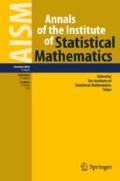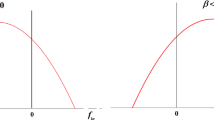Summary
A basic linear model of stationary stochastic processes is proposed for the analysis of linear feedback systems. The model suggests a simple computational procedure which gives estimates of the response characteristics of the system and the spectra of the noise source. These estimates are obtained through the estimate of the linear predictor of the process, which is obtained by the ordinary least squares method.
The necessary assumption for the validity of the estimation procedure is so general that the procedure can be applied to the analysis of wide variety of practical systems with feedback.
The content of the present paper forms an answer to the problem discussed by the author in a former paper [1].
Similar content being viewed by others
References
H. Akaike, “Some problems in the application of the cross-spectral method,”Spectral Analysis of Time Series (ed. B. Harris), New York, John Wiley (1967), 81–107.
H. Akaike, “On the statistical estimation of the frequency response function of a system having multiple input,”Ann. Inst. Statist. Math., 17 (1965), 185–210.
H. Akaike and Y. Yamanouchi, “On the statistical estimation of frequency response function,”Ann. Inst. Statist. Math., 14 (1962), 23–56.
J. Durbin, “Estimation of parameters in time-series regression models,”J. R. Statist., Soc., Series B, 22 (1960), 139–153.
H. B. Mann and A. Wald, “On the statistical treatment of linear stochastic difference equations,”Econometrica, 11 (1943), 173–220.
T. Otomo, T. Nakagawa and H. Akaike, “Implementation of computer control of a cement rotary kiln through data analysis,” submitted to the 4th congress of IFAC.
E. Parzen, “Analysis and synthesis of linear models for time series,” Technical Report No. 4, Department of Statistics, Stanford University, 1966.
E. Parzen, “On empirical multiple time series analysis,”Proc. 5th Berkeley Symposium, 1 (1967), 305–340.
P. Whittle, “The analysis of multiple stationary time series,”J. R. Statist. Soc., Series B, 15 (1953), 125–139.
N. Wiener and P. Masani, “The prediction theory of multivariate stochastic processes, Part I,”Acta Math., 98 (1957), 111–150.
H. Wold, “Ends and means in econometric model building,”Probability and Statistics (ed. V. Grenander), Almqvist & Wiksell, Stockholm, John Wiley & Sons, New York (1959), 355–434.
H. Wold, “Forecasting by the chain principle,”Time Series Analysis (ed. M. Rosenblatt), John Wiley & Sons, New York (1963), 471–497.
Author information
Authors and Affiliations
About this article
Cite this article
Akaike, H. On the use of a linear model for the identification of feedback systems. Ann Inst Stat Math 20, 425–439 (1968). https://doi.org/10.1007/BF02911655
Received:
Issue Date:
DOI: https://doi.org/10.1007/BF02911655



